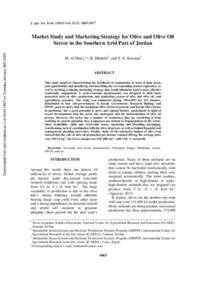Market Study and Marketing Strategy for Olive and Olive Oil Sector in the Southern Arid Part of Jordan

Authors:
This study aimed at characterizing the livelihood of communities in term of their assets and opportunities and identifying and describing the corresponding market segment(s), as well as devising a suitable marketing strategy that would ultimately lead to more effective community engagement. A socio-economic questionnaire was designed to elicit basic numerical data on olive production, and marketing system of olive and olive oil, and agricultural practices. The study was conducted during 2014-2015 for 155 farmers, distributed in four sub-governorates in Karak Governorate. Research findings and SWOT analysis shows that the Jordanian Olive Sector in general, and Karak Olive Sector in particular, has a good potential to grow and expand further, particularly in light of recent developments that the sector has undergone and the modernization of olive oil presses. However, the sector has a number of weaknesses that are restricting it from realizing its growth potential. Key weaknesses are related to fragmentation of the sector, labor availability, skills and work-ethic issues, marketing and branding, packaging, warehousing, lack of coordination with the olive oil presses as well as limited financial and management planning know-how. Finally, study of the enterprise budget of olive crop showed that the rate of olive oil production per hectare reached 650 kg, the average price was US$ 5.5 kg-1, the Gross margin was US$ 200 ha-1, with US$ net profit.
